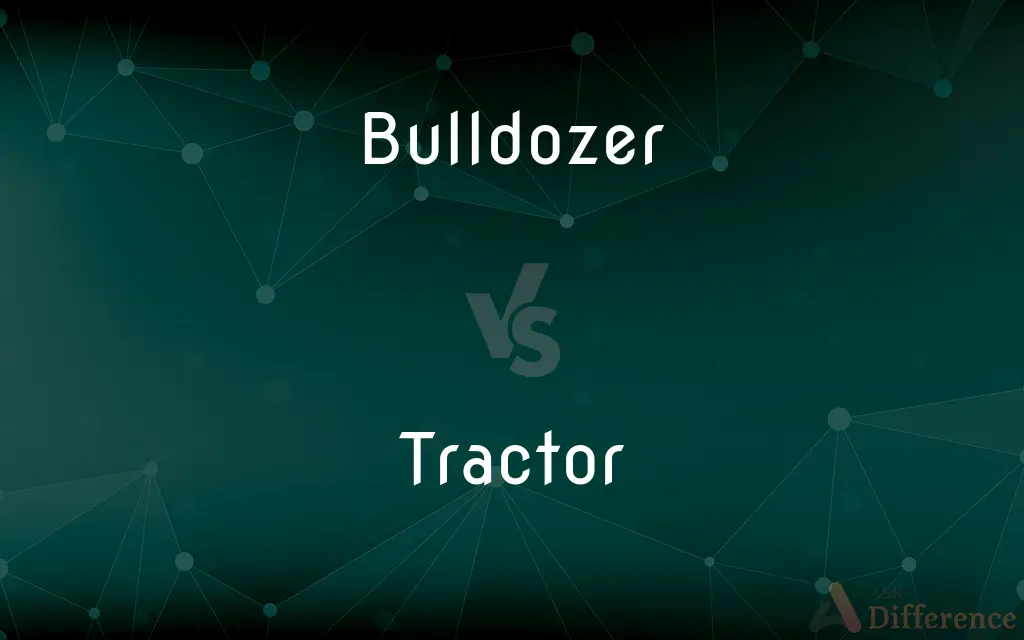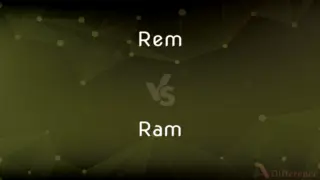Bulldozer vs. Tractor — What's the Difference?
By Tayyaba Rehman & Urooj Arif — Updated on April 26, 2024
Bulldozer, primarily used for pushing large quantities of soil and rubble, features a wide, flat blade; tractor, versatile in agriculture and construction, is equipped with a powerful engine and hitching capabilities.

Difference Between Bulldozer and Tractor
Table of Contents
ADVERTISEMENT
Key Differences
A bulldozer is characterized by its large, flat blade at the front, used primarily for pushing substantial amounts of earth and debris during construction activities. On the other hand, a tractor is typically recognized for its versatility in both agricultural and construction settings, equipped with a powerful engine to pull various types of machinery and implements.
Bulldozers are built with tracks which provide stability and exceptional ground holding capability, making them ideal for rough and uneven terrains typically found in construction sites. In contrast, tractors often come with either wheels or tracks, allowing them to operate on a variety of surfaces, from farms to construction sites, depending on the configuration.
The design of a bulldozer includes a significant focus on the blade and ripper, making it well-suited for heavy-duty clearing and grading tasks. Whereas, tractors are designed to serve as towing vehicles that can also power other machinery via PTO (Power Take-Off), making them indispensable in farming and heavy hauling.
Bulldozers are usually operated in environments that require substantial ground alteration, such as mining or large-scale construction. Tractors, however, are commonly used in agricultural settings to perform tasks like plowing, planting, and harvesting, though they are also useful in building projects for towing and operational assistance.
The operating environment of bulldozers demands a robust construction with minimal maintenance needs, to withstand tough working conditions. Conversely, tractors are generally designed with more comfort in mind, equipped with cabins and ergonomic features suitable for extended use in farming operations.
ADVERTISEMENT
Comparison Chart
Primary Use
Pushing soil and debris
Towing machinery and agricultural work
Design Focus
Blade and ripper for heavy-duty clearing
Hitching capabilities and PTO for versatility
Operating Terrain
Tracks for rough, uneven terrain
Wheels or tracks, suitable for varied surfaces
Typical Environment
Construction sites, mining
Farms, occasionally construction sites
Comfort and Maintenance
Minimal comfort, robust design
Ergonomic features for prolonged use
Compare with Definitions
Bulldozer
Heavy machinery used for pushing earth and rubble.
The construction site used a bulldozer to clear the area for the new building.
Tractor
Commonly found in agriculture and construction.
Tractors are as common in agricultural fields as they are at construction sites.
Bulldozer
Features like heavy-duty blades and rippers.
The bulldozer’s ripper tore through the hard soil easily.
Tractor
Operates with a power take-off system.
The tractor’s PTO drove the irrigation equipment efficiently.
Bulldozer
A tracked vehicle equipped with a wide blade.
The bulldozer’s tracks allowed it to move smoothly over the muddy ground.
Tractor
Can be equipped with various attachments.
The tractor was fitted with a loader bucket to move the harvested crops.
Bulldozer
Primarily employed in construction and mining.
Bulldozers are essential for preparing the land in mining operations.
Tractor
Designed for comfort and extended use.
The new tractor model featured an upgraded, comfortable cabin for long working hours.
Bulldozer
Known for robust construction.
Despite the harsh conditions, the bulldozer operated flawlessly.
Tractor
A vehicle used for pulling farm equipment.
The farmer hooked the plow to the tractor for tilling his field.
Bulldozer
An overbearing person; a bully.
Tractor
A vehicle having a powerful gasoline or diesel motor and usually large, heavily treaded rear tires, used especially for pulling farm implements or machinery.
Bulldozer
A bulldozer or dozer (also called a crawler) is a large, motorized machine that travels on continuous tracks or large tires and is equipped with a metal blade to the front for pushing material: soil, sand, snow, rubble, or rock during construction or conversion work. When needed, a hook-like device (termed a ripper) can be mounted on the rear to loosen dense materials.
Tractor
A tractor is an engineering vehicle specifically designed to deliver a high tractive effort (or torque) at slow speeds, for the purposes of hauling a trailer or machinery such as that used in agriculture, mining or construction. Most commonly, the term is used to describe a farm vehicle that provides the power and traction to mechanize agricultural tasks, especially (and originally) tillage, but nowadays a great variety of tasks.
Bulldozer
A powerful track-laying tractor with caterpillar tracks and a broad curved upright blade at the front for clearing ground.
Tractor
A powerful motor vehicle with large rear wheels, used chiefly on farms for hauling equipment and trailers.
Bulldozer
A heavy, driver-operated machine for clearing and grading land, usually having continuous treads and a broad hydraulic blade in front.
Tractor
A truck having a cab and no body, used for pulling large vehicles such as vans or trailers.
Bulldozer
A tractor with an attached blade for pushing earth and building debris for coarse preliminary surface grading, demolishing building structures, etc.
Tractor
An airplane propeller mounted in front of the supporting surfaces.
Bulldozer
One who bulldozes.
Tractor
An airplane having such a propeller.
Bulldozer
A member of a self-identified group of white US Southerners who colluded to influence outcomes of post-Reconstruction elections by intimidating, coercing and bullying black voters and legislators, including burning down houses and churches, flogging and murdering opponents.
Tractor
A toothed mechanism that automatically advances perforated continuous-form paper through a computer printer.
Bulldozer
(by extension) A bully; an overbearing individual.
Tractor
(agriculture) A vehicle used in farms e.g. for pulling farm equipment and preparing the fields.
Bulldozer
To bulldoze (push through forcefully).
They bulldozered through the crowd.
Tractor
(agriculture) A movable coop without a floor to allow for free ranging.
Bulldozer
One who bulldozes.
Tractor
(US) A truck (or lorry) for pulling a semi-trailer or trailer.
Bulldozer
Large powerful tractor; a large blade in front flattens areas of ground
Tractor
Any piece of machinery that pulls something.
Tractor
(aviation) An aeroplane where the propeller is located in front of the fuselage.
Tractor
A British Rail Class 37 locomotive.
Tractor
(archaic) A metal rod used in tractoration, or Perkinism.
Tractor
To prepare (land) with a tractor.
Tractor
To move with a tractor beam.
Tractor
To treat by means of tractoration, or Perkinism.
Tractor
That which draws, or is used for drawing.
Tractor
Two small, pointed rods of metal, formerly used in the treatment called Perkinism.
Tractor
A motor vehicle with a powerful engine and large wheels, used to pull farm equipment such as plows, harvesting machinery, etc., over farm land. Smaller forms of farm tractor are completely open, with only a seat for the driver.
Tractor
A motor vehicle with a driver's cab and a powerful engine, fitted with a coupling at the rear, and designed to pull a large trailer or semi-trailer on the open highway; - called also truck tractor. The combination of such a tractor with its trailer is called a tractor-trailer, and is a common form of truck used for commercial shipping of freight.
Tractor
A propeller screw placed in front of the supporting planes of an aëroplane instead of behind them, so that it exerts a pull instead of a push; - called also Tractor screw and Tractor propeller.
Tractor
An airplane having one or more tractor propellers; - called also tractor airplane.
Tractor
A wheeled vehicle with large wheels; used in farming and other applications
Tractor
A truck that has a cab but no body; used for pulling large trailers or vans
Common Curiosities
What type of blade does a bulldozer use?
Bulldozers use a wide, flat blade called a bulldozer blade, which can be adjusted to move soil and rubble efficiently.
What are the typical safety features of a bulldozer?
Typical safety features of a bulldozer include rollover protection structures (ROPS), seat belts, and sometimes cabins to protect the operator.
How is a tractor's versatility beneficial in agriculture?
A tractor's versatility allows it to perform multiple tasks with different attachments, such as plowing, seeding, and harvesting, making it indispensable in modern farming.
What makes bulldozers effective for use in mining operations?
Bulldozers are effective in mining due to their strong build, powerful pushing capacity, and ability to operate on diverse and rugged terrains.
Can tractors be used in industries other than agriculture?
Yes, tractors are also commonly used in construction, landscaping, and even in some industrial applications where towing and power are required.
Are there electric models of tractors or bulldozers?
Yes, there are electric models for both tractors and bulldozers, which are designed to reduce emissions and decrease operating costs.
How do the maintenance needs of tractors and bulldozers compare?
Tractors generally require more regular maintenance due to their complex mechanisms like the PTO and varied attachments, whereas bulldozers are built for durability with less frequent maintenance schedules.
How do the environmental impacts of using bulldozers and tractors compare?
Both bulldozers and tractors significantly impact the environment by altering land structures and potentially contributing to emissions; however, the impact varies based on the scale of operations and fuel efficiency.
What is the average lifespan of a bulldozer compared to a tractor?
The lifespan of a bulldozer or a tractor depends on maintenance and usage, but generally, bulldozers have a longer lifespan due to their robust construction designed for tough conditions.
How has technology advanced in the design of tractors and bulldozers?
Advances in technology have led to the inclusion of GPS for precision tasks, improved fuel efficiency, and enhanced operator comfort and safety features in both tractors and bulldozers.
Can a bulldozer be fitted with attachments like a tractor?
While bulldozers can be fitted with different blades and rippers, they are not as versatile in terms of attachments as tractors, which can accommodate a wider range of equipment.
What type of engine powers a bulldozer?
Bulldozers are typically powered by large diesel engines designed to deliver high torque for heavy-duty pushing tasks.
What is the role of hydraulics in tractors?
Hydraulics in tractors play a crucial role in operating attached implements and in steering and lifting mechanisms, enhancing the tractor’s efficiency and versatility.
How does the weight of a bulldozer affect its functionality?
The heavy weight of a bulldozer helps it exert more force on the ground, enhancing its ability to push large volumes of soil and debris.
What training is required to operate a bulldozer or tractor?
Operating a bulldozer or tractor requires specific training and certification, focusing on safety, machine operation, and sometimes specialized tasks depending on the machinery type.
Share Your Discovery

Previous Comparison
Rem vs. Ram
Next Comparison
Demarcated vs. DemarkedAuthor Spotlight
Written by
Tayyaba RehmanTayyaba Rehman is a distinguished writer, currently serving as a primary contributor to askdifference.com. As a researcher in semantics and etymology, Tayyaba's passion for the complexity of languages and their distinctions has found a perfect home on the platform. Tayyaba delves into the intricacies of language, distinguishing between commonly confused words and phrases, thereby providing clarity for readers worldwide.
Co-written by
Urooj ArifUrooj is a skilled content writer at Ask Difference, known for her exceptional ability to simplify complex topics into engaging and informative content. With a passion for research and a flair for clear, concise writing, she consistently delivers articles that resonate with our diverse audience.














































